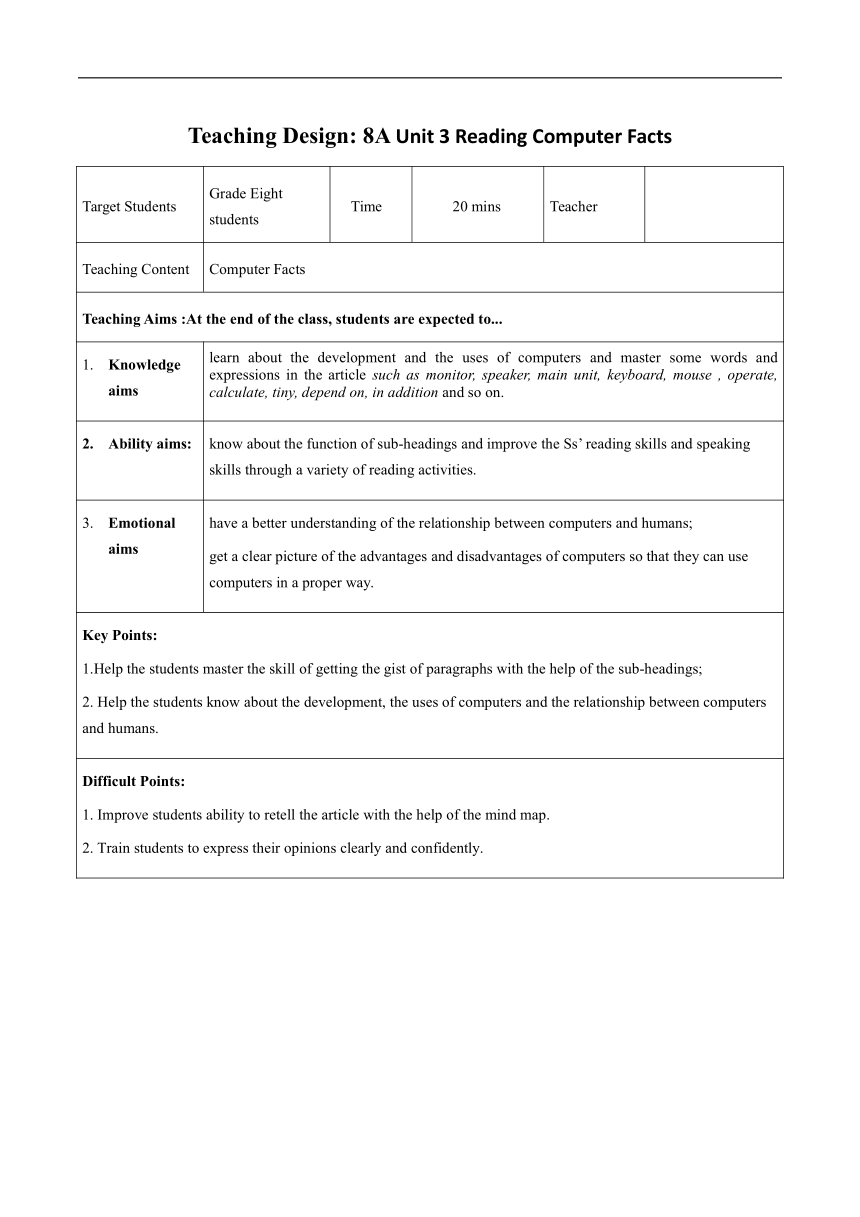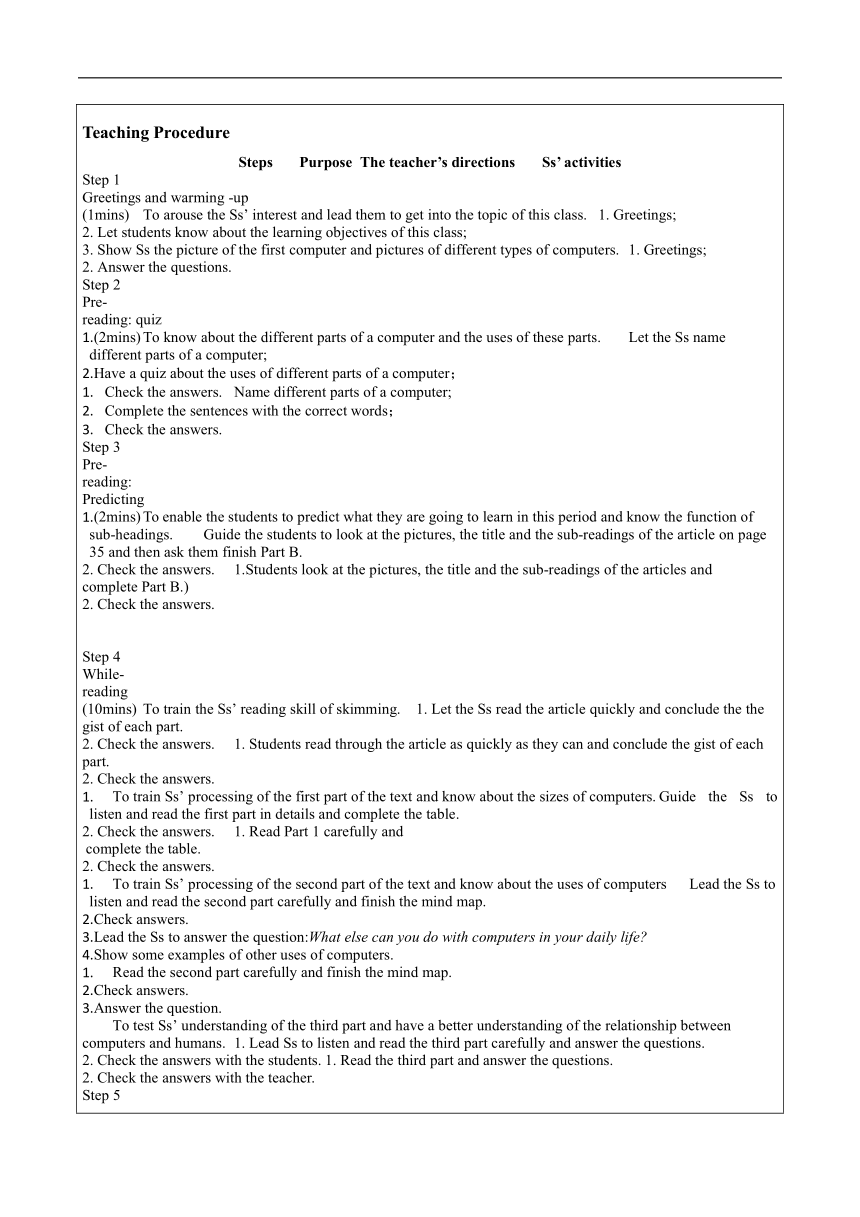Unit 3 A day out Reading 表格式教案
文档属性
| 名称 | Unit 3 A day out Reading 表格式教案 |  | |
| 格式 | docx | ||
| 文件大小 | 21.7KB | ||
| 资源类型 | 教案 | ||
| 版本资源 | 牛津译林版 | ||
| 科目 | 英语 | ||
| 更新时间 | 2022-08-14 16:32:14 | ||
图片预览


文档简介
Teaching Design: 8A Unit 3 Reading Computer Facts
Target Students Grade Eight students Time 20 mins Teacher
Teaching Content Computer Facts
Teaching Aims :At the end of the class, students are expected to...
Knowledge aims learn about the development and the uses of computers and master some words and expressions in the article such as monitor, speaker, main unit, keyboard, mouse , operate, calculate, tiny, depend on, in addition and so on.
Ability aims: know about the function of sub-headings and improve the Ss’ reading skills and speaking skills through a variety of reading activities.
Emotional aims have a better understanding of the relationship between computers and humans; get a clear picture of the advantages and disadvantages of computers so that they can use computers in a proper way.
Key Points: 1.Help the students master the skill of getting the gist of paragraphs with the help of the sub-headings; 2. Help the students know about the development, the uses of computers and the relationship between computers and humans.
Difficult Points: 1. Improve students ability to retell the article with the help of the mind map. 2. Train students to express their opinions clearly and confidently.
Teaching Procedure Steps Purpose The teacher’s directions Ss’ activities Step 1 Greetings and warming -up (1mins) To arouse the Ss’ interest and lead them to get into the topic of this class. 1. Greetings; 2. Let students know about the learning objectives of this class; 3. Show Ss the picture of the first computer and pictures of different types of computers. 1. Greetings; 2. Answer the questions. Step 2 Pre- reading: quiz (2mins) To know about the different parts of a computer and the uses of these parts. Let the Ss name different parts of a computer; Have a quiz about the uses of different parts of a computer; Check the answers. Name different parts of a computer; Complete the sentences with the correct words; Check the answers. Step 3 Pre- reading: Predicting (2mins) To enable the students to predict what they are going to learn in this period and know the function of sub-headings. Guide the students to look at the pictures, the title and the sub-readings of the article on page 35 and then ask them finish Part B. 2. Check the answers. 1.Students look at the pictures, the title and the sub-readings of the articles and complete Part B.) 2. Check the answers. Step 4 While- reading (10mins) To train the Ss’ reading skill of skimming. 1. Let the Ss read the article quickly and conclude the the gist of each part. 2. Check the answers. 1. Students read through the article as quickly as they can and conclude the gist of each part. 2. Check the answers. To train Ss’ processing of the first part of the text and know about the sizes of computers. Guide the Ss to listen and read the first part in details and complete the table. 2. Check the answers. 1. Read Part 1 carefully and complete the table. 2. Check the answers. To train Ss’ processing of the second part of the text and know about the uses of computers Lead the Ss to listen and read the second part carefully and finish the mind map. Check answers. Lead the Ss to answer the question:What else can you do with computers in your daily life Show some examples of other uses of computers. Read the second part carefully and finish the mind map. Check answers. Answer the question. To test Ss’ understanding of the third part and have a better understanding of the relationship between computers and humans. 1. Lead Ss to listen and read the third part carefully and answer the questions. 2. Check the answers with the students. 1. Read the third part and answer the questions. 2. Check the answers with the teacher. Step 5 Post- reading (5mins) To train the Ss’ ability of retelling the article. Guide the Ss to retell the article based on the mind map. Present a possible version for the Ss. 1.Retell the article with the help of the mind map. 2. Read the possible version together. To enable the Ss to guess the meaning of new words based on the context. Let the Ss finish the exercise C1. 2. Check the answers with the students. 1. Complete the exercise C1. 2. Check the answers with the teacher. 3. Take notes. To improve the Ss’ speaking skills and thinking ability. 1.Guide the Ss to discuss and answer the questions: Do you depend on computers a lot in your daily life Give examples. Do you agree that computers will be able to do all our jobs in the future Give reasons. Share my Ss’ answers. 1. Answer the questions. 2. Listen to the two students’ answers. Step 6 Home work To improve the Ss’ writing skills and improve their understanding of computers Let S's finish the writing task: Write a composition about the advantages and disadvantages that the computer brings to you. Finish the writing task.
Target Students Grade Eight students Time 20 mins Teacher
Teaching Content Computer Facts
Teaching Aims :At the end of the class, students are expected to...
Knowledge aims learn about the development and the uses of computers and master some words and expressions in the article such as monitor, speaker, main unit, keyboard, mouse , operate, calculate, tiny, depend on, in addition and so on.
Ability aims: know about the function of sub-headings and improve the Ss’ reading skills and speaking skills through a variety of reading activities.
Emotional aims have a better understanding of the relationship between computers and humans; get a clear picture of the advantages and disadvantages of computers so that they can use computers in a proper way.
Key Points: 1.Help the students master the skill of getting the gist of paragraphs with the help of the sub-headings; 2. Help the students know about the development, the uses of computers and the relationship between computers and humans.
Difficult Points: 1. Improve students ability to retell the article with the help of the mind map. 2. Train students to express their opinions clearly and confidently.
Teaching Procedure Steps Purpose The teacher’s directions Ss’ activities Step 1 Greetings and warming -up (1mins) To arouse the Ss’ interest and lead them to get into the topic of this class. 1. Greetings; 2. Let students know about the learning objectives of this class; 3. Show Ss the picture of the first computer and pictures of different types of computers. 1. Greetings; 2. Answer the questions. Step 2 Pre- reading: quiz (2mins) To know about the different parts of a computer and the uses of these parts. Let the Ss name different parts of a computer; Have a quiz about the uses of different parts of a computer; Check the answers. Name different parts of a computer; Complete the sentences with the correct words; Check the answers. Step 3 Pre- reading: Predicting (2mins) To enable the students to predict what they are going to learn in this period and know the function of sub-headings. Guide the students to look at the pictures, the title and the sub-readings of the article on page 35 and then ask them finish Part B. 2. Check the answers. 1.Students look at the pictures, the title and the sub-readings of the articles and complete Part B.) 2. Check the answers. Step 4 While- reading (10mins) To train the Ss’ reading skill of skimming. 1. Let the Ss read the article quickly and conclude the the gist of each part. 2. Check the answers. 1. Students read through the article as quickly as they can and conclude the gist of each part. 2. Check the answers. To train Ss’ processing of the first part of the text and know about the sizes of computers. Guide the Ss to listen and read the first part in details and complete the table. 2. Check the answers. 1. Read Part 1 carefully and complete the table. 2. Check the answers. To train Ss’ processing of the second part of the text and know about the uses of computers Lead the Ss to listen and read the second part carefully and finish the mind map. Check answers. Lead the Ss to answer the question:What else can you do with computers in your daily life Show some examples of other uses of computers. Read the second part carefully and finish the mind map. Check answers. Answer the question. To test Ss’ understanding of the third part and have a better understanding of the relationship between computers and humans. 1. Lead Ss to listen and read the third part carefully and answer the questions. 2. Check the answers with the students. 1. Read the third part and answer the questions. 2. Check the answers with the teacher. Step 5 Post- reading (5mins) To train the Ss’ ability of retelling the article. Guide the Ss to retell the article based on the mind map. Present a possible version for the Ss. 1.Retell the article with the help of the mind map. 2. Read the possible version together. To enable the Ss to guess the meaning of new words based on the context. Let the Ss finish the exercise C1. 2. Check the answers with the students. 1. Complete the exercise C1. 2. Check the answers with the teacher. 3. Take notes. To improve the Ss’ speaking skills and thinking ability. 1.Guide the Ss to discuss and answer the questions: Do you depend on computers a lot in your daily life Give examples. Do you agree that computers will be able to do all our jobs in the future Give reasons. Share my Ss’ answers. 1. Answer the questions. 2. Listen to the two students’ answers. Step 6 Home work To improve the Ss’ writing skills and improve their understanding of computers Let S's finish the writing task: Write a composition about the advantages and disadvantages that the computer brings to you. Finish the writing task.
